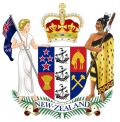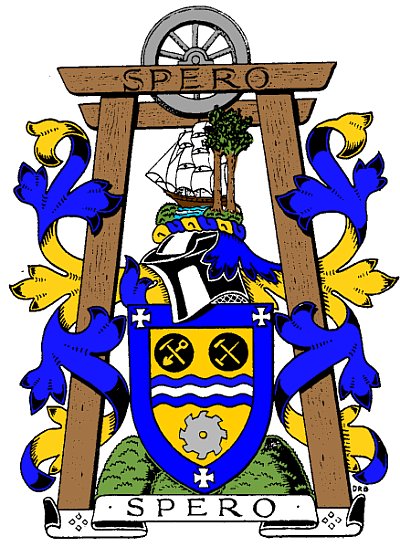Thames
New Zealand heraldry portal
This page is part of the New Zealand heraldry portal |
Heraldry of the World |
|
Civic heraldry:
|
Other heraldry: |
THAMES
Region: Waikato
District : Thames-Coromandel
Official blazon
?
Origin/meaning
Following the creation of the borough of Thames in 1874, a competition was held to design a borough seal, and the winning design was used for a hundred years. It comprised a shield which rested upon a mining head frame complete with a pulley wheel. the top support beam of the frame bearing the motto SPERO meaning I Hope. In the space above the top of the shield was a fully rigged sailing vessel, indicating shipping., Thames then having no land communications. The shield itself bears on its upper section an early steam locomotive; like the one named Jumping Jinny, drawing a carriage, for the mile long local railway of 1869, which was very early for New Zealand. The lower part of the shield showed a sailing vessel on a slipway, to convey the shipbuilding industry, and beneath it a circular saw blade, denoting sawmilling. On one side of the shield were a pick and shovel. these to indicate the mining industry, and on the other side a hammer and drill, representing engineering and mining. Below the shield was a Maori canoe and in the background were mounts whose shapes suggest a double allusion to the historic gold-bearing hills and the great mine tips.
With the object of noting the centennial of the borough, which occurred in 1973, a decision was made by the mayor and councillors to. make application for armorial bearings and a badge, accordingly arms were granted by the College of Arms, London on 1st March 1974. The armorial bearings and badge are based on the original seal. with an improvement in the shape of the shield. On a gold field, a pick and shovel and a hammer and drill have been placed on two black roundels in chief, and a circular saw occupies the base. The blue and silver wavy bars across the centre of the shield signify the River Thames, the name given by Captain Cook to what is now known as the Waihou River and the Firth of Thames. The shield has a blue border upon which rest three silver formy crosses, these deriving from like charges in the arms of the Borough of Abingdon, Berkshire, in England, with which the Borough of Thames exchanged Freedoms. The crest comprises a fully rigged eighteenth century sailing ship on a river between two grassy mounts n+o the one on the port side of the ship having two kauri trees growing on it. While not specifically meant to be Cook's ship, H.M. Bark Endeavour, it is of that period and could be so regarded, but is really no more than a symbol of the main method of transport to and from Thames in the early days, which was by sea.
The wreath and mantling are gold and blue, the main colours of the shield. The badge, which is shown in the, illustration as a background to the achievement, is an improved version of the mining head frame and poppet head with the cross beam carved with the word Spero as used in the original seal, with three grassy mounts at the base. The mantling is shown entwined around the supporting posts. The best elements of the seal have therefore been skilfully retained and improved upon in both the achievement and badge, creating arms and a badge of excellence.
On 1st October, 1975, the borough of Thames amalgamated with two county Councils to form the Thames Coromandel District Council. Although the new Council was refused permission to carry on using the arms, the Council resolved to continue to use the former borough arms on its letterhead, and continued to do so until 1990.
Contact and Support
Partners:
Your logo here ?
Contact us
© since 1995, Heraldry of the World, Ralf Hartemink 
Index of the site
Literature : Information provided by Lawrence Jones.












